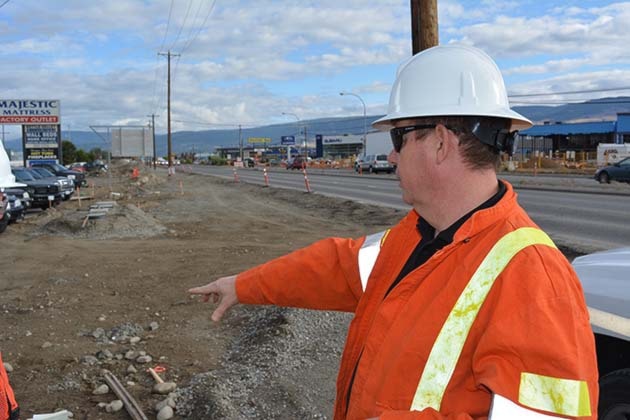Working together with the Ministry of Highways as well as other utility providers such as the cable companies, Fortis BC says its $5.5 million dollar project to remove power poles and bury power lines along a four kilometre stretch of Highway 97 will help beautify Kelowna and make its power system more efficient.
Fortis BC held a media briefing along its project on Highway 97 between Reid's Corner and Highway 33 on Thursday, a project that is taking place while the the Ministry of Transportation works on a $36 million dollar project, widening the stretch of highway from four lanes up to six.
With construction underway and continuing through to the end of 2017, Fortis BC was able to piggy-back on the construction and move its power lines underground.
By the end, about 50 power poles will disappear from the skyline with wires being buried alongside the new highway in the largest single project of its kind undertaken by Fortis BC in Kelowna.
"This project was a good opportunity to put in multiple services at once," said Rob Maschek, Fortis BC project manager. "You can see how much cleaner this corridor will look. It's part of the urbanization of the area. In these major projects we all try to work together, to collaborate, right from the design stage through construction."
Fortis BC will work the four kilometre stretch in nine different sections. As the old road is dug up to make way for the new highway, crews from Fortis, Shaw and Telus move in to bury their wires. In the past, wires and power poles have been removed from Highway 33 to downtown Kelowna while the new project will remove the rest of the poles and wires all the way to Sexsmith.
Maschek says having power wires buried allows for a more efficient system.
"It's not necessarily better, (burying wires) provides a longer life," he said. "Wooden poles deteriorate and need to be maintained every eight years while underground wires are good for about 40 years."
It also takes driver error out of the equation when it comes to power disruptions, said Nicole Bogdanovic, Fortis BC communications specialist. She said an accident last week that saw 1,300 Glenmore residents lose power for an extended amount of time due to a car hitting a power pole, wouldn't have happened had the wires been buried.
"By moving from overhead to underground, service is not going to be impacted by a motor vehicle accident and that's a huge benefit," she said, adding the area will look much nicer without overhead wiring. "It will clean up this corridor and help with the look as people come into town."
Fortis has completed the first of its nine sections having removed the overhead wiring from Highway 33 to Leathead and is now working on the stretch from Leathead to McCurdy with an estimated completion date of that stretch by the end of the year.
The entire paving project is expected to be done by the end of 2017 with work going on at night for much of the next year.
Maschek says overall he estimates about 30 per cent of power lines in Kelowna are now underground with new construction in Kelowna mandated to bury power lines.
"I don't think if we will get to where Europe is with all power lines underground, but where it makes sense we will do it. We have to balance the conversion with the cost of doing it. This project created the opportunity to do this."
